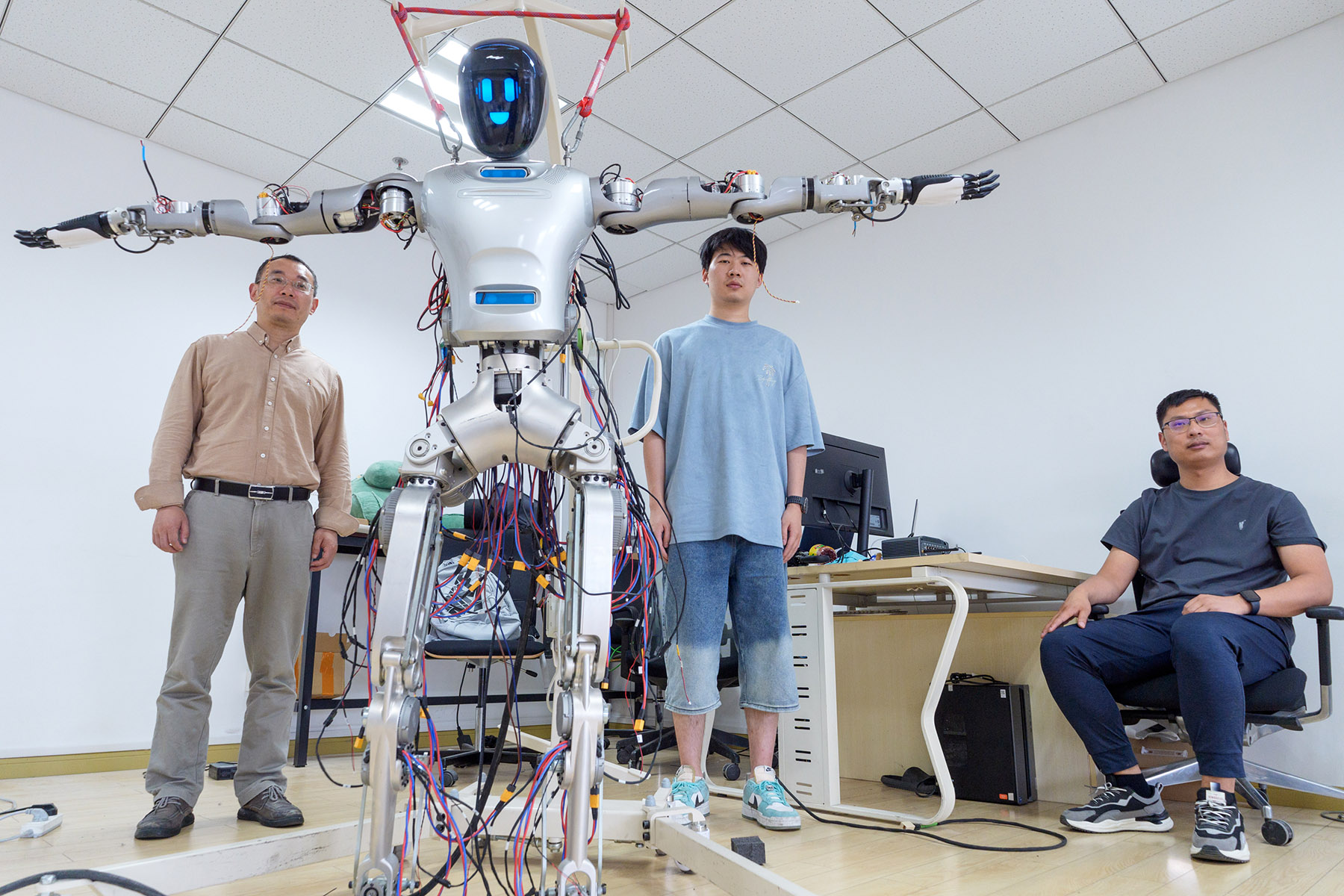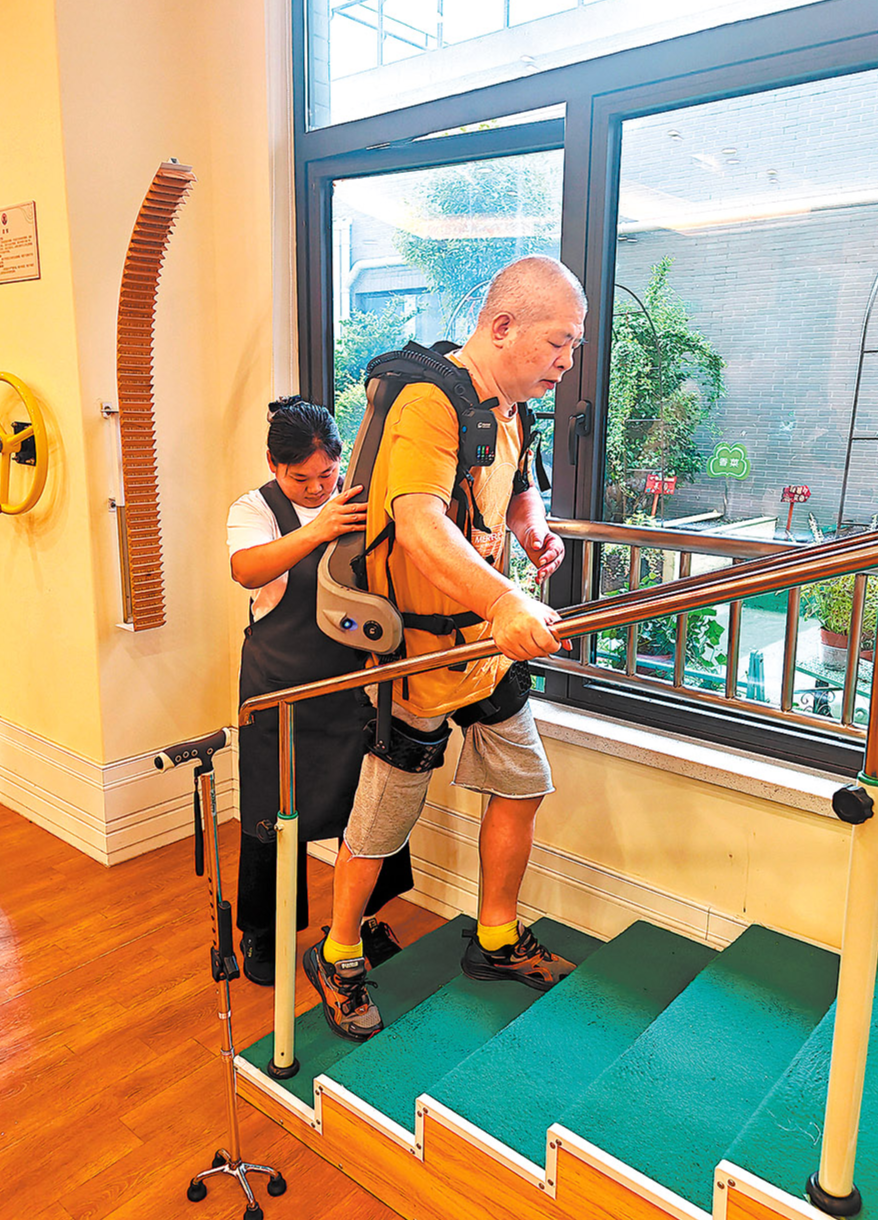Intelligent self-driving wheelchairs, automated exoskeletons will assist aging population, experts say

In the not too distant future, humanoid robots will not only be able to perform caregiver tasks for the elderly, such as pushing them in a wheelchair, but also react to them with a range of sympathetic "emotions", according to a leading developer.
Liu Lizheng, head of humanoid robot projects at Shanghai's Fudan University, said he believes that from a technical point of view these functions will be achieved in three to five years.
"In order for the elderly to accept being cared for by robots, they must be not only intelligent enough in fulfilling tasks, but also interactive in emotional aspects, so elderly users feel a sense of warmth and companionship akin to that of a loved one," said Liu.
The Guanghua No 1 humanoid robot developed by his team is currently undergoing iterative software development and is set to make its debut at a top-tier hospital in Shanghai before the end of this year. The robot will demonstrate its application in elderly healthcare scenarios, Liu said.
READ MORE: China leads global effort with international standard for elderly-care robots
The team's goal is to develop the robot into a highly secure, learning-capable one that takes the initiative in recognizing different scenarios when looking after an elderly person. The ultimate objective is to replace the role of a human in around-the-clock caregiving.
At the International Exhibition of Senior Care, Rehabilitation Medicine and Healthcare Shanghai 2025 held in the city from June 11 to 13, over 500 domestic and foreign enterprises showcased their latest elderly care products, including exoskeleton robots and intelligent self-driving wheelchairs. Industry insiders described the development of caregiver robots as the start of an "explosive era" in the sector.
"These innovations mark three key shifts in China's silver economy: from functional substitution to human-machine integration in technology, from passive adaptation to active empowerment in product design, and from single care to a full scenario quality of life enhancement in service ecosystems," said Ma Zhiwen, assistant general manager of Shanghai International Exhibition (Group) Co, a co-organizer of the exhibition.

Emotional interactions
The Guanghua No 1 humanoid robot, developed by Fudan University's Academy for Engineering and Technology, made its public debut in July 2024. Standing 165 centimeters and weighing 62 kilograms, the robot is capable of walking upright and displaying facial expressions. Its developers describe it as "a robot with human-like emotions that can complete flexible and delicate operations".
One of the robot's key features is its ability to perceive and respond to users' emotions. It has an animated "cartoon-like" face that so far can express 21 different emotions, including joy, excitement, anger and sorrow.
To achieve this level of emotional intelligence and interactivity, a multidisciplinary team — drawn from mechanics, biology, engineering, computing, and big data — has spent over three years developing the robot's response system.
"By integrating brain-inspired dynamics and dopamine-like reward mechanisms, along with multi-level coordinated reinforcement algorithms, the robot's perception and behaviors have been refined to be more human-like and subtle, enabling multi-modal emotion generation," Liu said.
In addition to emotional engagement, the robot's physical interactions with elderly individuals must be gentle and precise.
Equipped with dozens of variably geared intelligent joints and a hierarchical generative body-brain model, the robot is expected to perform a wide range of actions in the future, the researchers said. It will also have real-time adaptability to cater to various needs, such as lifting objects of different textures and sizes.
Compared with robots that perform general household duties, caregiver robots, which will have intensive interaction with humans, require a higher level of safety and precision.
"The daily routine of such a robot includes helping the elderly get up from a bed and supporting them to get to the bathroom," Liu said. "This is very different from a housework robot that sweeps the floor and folds clothes most of the time, which is usually not done in the presence of humans.
"An extreme example is the case of a robot colliding with an elderly user; it must execute protective actions promptly," he said.
The ultimate goal of the robot, which unlike a human carer will never lose its temper, is to comprehend users' intentions, and generalize its capability to deal with complex scenarios. The robot will need to be charged once a day, like a mobile phone.
"After entering a family environment, the robot observes the individuals' behaviors and habits and optimizes its actions and workflow accordingly," Liu said. "The way people clean the floor may differ, and there are vastly different cooking styles and taste preferences. The robot must continuously learn autonomously to adapt to each elderly person and household."
Several domestic and foreign teams are developing similar caregiver robots for the elderly, a recognition of the urgent need for such solutions, the Fudan team said. China is currently at the forefront of global research and development in this field, they added.
Guanghua No 1 humanoid robot currently supports six languages: Chinese, English, French, German, Spanish, and Russian. Companies in countries, including Singapore, Japan and Russia, all of which have aging populations, have expressed interest in the robot, the research team said, adding the issue is a shared global challenge.
After mass production, the retail price of the robot is expected to be between 100,000 yuan ($13,928) and 200,000 yuan, Liu said.

Exoskeletons ease burden
This year's Shanghai exhibition attracted brands from 16 countries and regions, and spanned an exhibition space of 50,000 square meters, the largest in the event's 25-year history.
Some smart technologies showcased at the event have already hit the market.
They include an intelligent self-driving wheelchair developed by Ankangtong, a Shanghai-based enterprise specializing in home care products. The wheelchair is already in use in some upscale care institutions for the elderly in Shanghai, and also helped establish an industry standard via its involvement in a pilot project in Pudong New Area.
Utilizing advanced navigation systems, the wheelchair can autonomously navigate indoor and outdoor environments, offering features like obstacle avoidance and real-time fall detection. It also incorporates voice functions that are compatible with various dialects, and enables remote video calls. Such features foster independence for elderly users while allowing them to stay connected to their families at all times, Ankangtong said.
Another product with various practical applications is an exoskeleton robot developed by ULS Robotics, a high-tech enterprise founded in Shanghai in 2018. Elderly people with weak muscles can regain movement in their knees and hips by wearing an exoskeleton robot, the company said.
Ye Qing, a 75-year-old Shanghai resident, has experienced its benefits. He developed muscle atrophy and had difficulty walking after being laid up in the hospital for two months following surgery. Ye tried out the exoskeleton robot in April while ULS Robotics was cooperating with communities that have high proportions of elderly residents. The elders were given a free trial and asked to give feedback.
"After wearing the device, I felt like it was driving my legs to walk, and I could lift my legs without making much effort," Ye said. "I wasn't able to walk on the stairs before, but it made it much easier for me to go up and down the steps," he said.
The exoskeleton weighs 5 kilograms and takes around 30 seconds to put on or remove. It has already had practical application in some nursing homes.
Human caregivers who wear the device gain a "superpower" as it provides them up to 30 kg of assistance when carrying a weight, and reduces the carrying burden on them by more than 60 percent, the company said.
Xie Hongjun is a caregiver at Xiayang Subdistrict Nursing Home in Shanghai's Qingpu district. Since the exoskeleton robots began trial operations at the home in April last year, she has experienced significant relief from physical strain. Her daily routine involves taking care of six elderly people, which means helping them get up and down, turning them over in bed, and moving them around.
"I can clearly feel that the exoskeleton robot helps me reduce the burden on my waist. When I bend over, I feel like it's pushing. And when I help an elderly individual get up from a bed or chair, I feel like it's lifting them for me so I don't have to make as much effort," she said.
According to the latest data from the National Bureau of Statistics, China's population aged 60 and above exceeded 300 million for the first time by the end of 2024, reaching 310 million, and accounting for 22 percent of the total population. Experts predicted this number will surpass 400 million around 2035.
In January 2024, the General Office of the State Council issued a document on developing the silver economy to enhance the well-being of the elderly, elevating the silver economy to an international economic strategic level.
Shanghai, as one of the earliest and most heavily impacted cities by population aging, released a set of policy measures in December to promote high-quality innovations and upgrades of the silver economy through policy guidance and market-driven initiatives.

Lighter, more affordable
Zhang Hua, marketing director of ULS Robotics, said their products have been applied in the industrial field, including equipment manufacturing and logistics enterprises, for years, with exports to 17 countries. However, they have only been tested in China's elderly care system for a year.
Challenges include making the design more lightweight and reducing costs while transforming the products from industrial and hospital rehabilitation use to elderly care applications, Zhang said.
"When exoskeleton robots become a household product, people's expectation is that they should be as light as clothes. We've been able to continuously reduce the weight of the product from tens of kilograms. We are scheduled to release an 800-gram product during the World Artificial Intelligence Conference held in Shanghai this July," he said.
The company has also made continuous progress in cost reduction. While an exoskeleton robot used for medical rehabilitation at a hospital costs millions of yuan, the target price for a household device is 4,000 yuan to 8,000 yuan, making it as "affordable as a smartphone", Zhang said.
By 2030, the global market for eldercare exoskeleton robots could reach a staggering 48 billion yuan, according to industry forecasts.
ALSO READ: Advisers foresee Shanghai as humanoid robotics hub
ULS Robotics said that from a technical perspective, robots worn on the human body are even more complex than humanoid robots, as every person's gait differs. Once a user puts on an exoskeleton robot, the system must quickly respond to his or her needs and pace, deducing whether the user wants to walk on flat ground or go up and down stairs, and how high the legs need to be lifted.
"Moreover, many elderly people have underlying health issues, which cause their gait to be incorrect. This requires the robot to be smarter in order to perceive, learn, and adapt to the user, rather than just enhancing his or her movements," said Zhang.
At the International Consumer Electronics Show held in Las Vegas in January, Zhang observed that robots in the elderly care sector were mainly divided into three categories: service-oriented humanoid robots, function-enhancing exoskeletons that help seniors regain the joy and self-esteem of taking care of themselves, and emotional support companions, which were usually in the form of companion animals.
"It is anticipated that within the next decade or two, a wide array of robotic solutions will become commonplace in households worldwide, revolutionizing the way we care for and support our aging population," Zhang said.
Contact the writer at zhouwenting@chinadaily.com.cn


